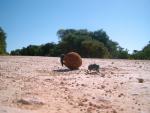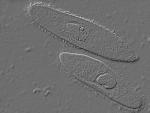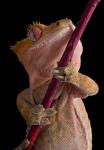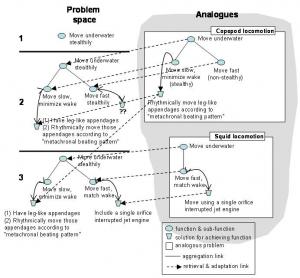Research Review: Biologically Inspired Design (Shu, Ueda, Chiu, Cheong)
 Shu, L.H., Ueda, K., Chiu, I., Cheong, H., 2011, CIRP Keynote Address on Biomimetics in Manufacturing, presented at the 61st CIRP General Assembly, Budapest, Hungary, August 21-27, 2011 (In Press).
Shu, L.H., Ueda, K., Chiu, I., Cheong, H., 2011, CIRP Keynote Address on Biomimetics in Manufacturing, presented at the 61st CIRP General Assembly, Budapest, Hungary, August 21-27, 2011 (In Press).
This paper explores how manufacturing can be inspired by natural processes through case studies, research and a wealth of references. After an overview of terminology, the paper surveys a wide range of examples, presents general methods supporting biomimetic design, describes the design process of three case studies and closes with observations and insights. This article summarizes the key points of the article with an emphasis on process issues of particular interest to designers.
Examples
Biological research suggests a wide range of opportunities for manufacturing at micro and nano levels, more sustainable water-based processes at ambient temperatures, improved life-cycle engineering and the implications of self-cleaning, self-assembly and self-organization at multiple levels. Examples of bio-inspiration in manufacturing are arranged in three main groups.
Cutting and Forming
-
 hypodermic needle (mosquito proboscis)
hypodermic needle (mosquito proboscis) - self-sharpening shredder blades (rodent teeth)
- surgical scissors (piranha teeth)
-
 drill design (wood wasp ovipositor, earthworm)
drill design (wood wasp ovipositor, earthworm) - freeze casting of materials with structured pores (observation of freezing)
- biotemplating (biomineralization)
- fiber manufacturing (spider silk spinning process)
Surfaces, Precision Engineering, Micro and Nano Machines
-
 silica coatings (biopolymers)
silica coatings (biopolymers) - self-cleaning (Lotus Effect, dung beetles)
- resistance to wear (dung beetles)
-
 ‘growing’ structured nano-components (morphogenesis, biomineralization)
‘growing’ structured nano-components (morphogenesis, biomineralization) - sensors (cat soleus muscle, squash/cucumber tendrils, seal whiskers, fish lateral line)
- microfluidic mixing and drug deliver (cilia)
Assembly, Disassembly, Modeling and Control
-

 micro-positioning (cell microtubule organizing center, abscission)
micro-positioning (cell microtubule organizing center, abscission) - dry adhesives (van der Waals forces: gecko/insect feet)
- repairable snap fittings (sacrificial parts)
- simultaneous disassembly (frog foot)
- authorized disassembly (biological ‘lock and key’)
- self-assembly of physical components (natural self-assembly determined by component and environmental characteristics)
- dynamic and adaptive manufacturing systems (self-organization, evolution, DNA, learning, immune systems)
- product evolution (cladistics)
- control and scheduling (genetics, path optimization using pheromones)
Methods
To effectively practice bio-inspired design, designers need tools, methods and access to information that spans from the molecular to the biosphere. Designers often look to organisms for solutions, missing opportunities to solve the problem at a different level in the system. The paper reviews research into two related areas:
- searching, retrieving and representing biological information
- understanding the process of applying biological analogies to design challenges
Solution-Driven
In the solution-driven approach, designers start with a biological phenomenon and look for applications. Finding a ‘good’ biological phenomenon and not fixating on the first one encountered can be a crucial success factor. Knowledge of biology is important, and transferring the biological knowledge to the technical domain often proves to be difficult. Key steps include:
- defining the biological solution by developing a deep understanding of the biological system (functional decomposition) including how organisms balance opposing functional goals (functional optimization)
- extracting the key principles, removing references to the biological structural and environmental entities
- reframing the solution in terms relevant to human needs and goals
- searching for relevant human problems
- defining the human problem using functional decomposition and optimization
- applying the key principles to develop a solution, taking into account any additional engineering constraints
Problem-Driven
 In the problem-driven approach, designers start with a problem and search for relevant biological analogies that might suggest innovative solutions. The most common approach is to decompose the problem into a hierarchy of functions which can then be mapped to biological analogies. These functions should be stated in generic terms to avoid limiting the domain of possible solutions. Using verbs is better than nouns while adjectives can describe desired qualities but should be used with caution. Concerns have been raised that ‘biologizing the problem’ can similarly constrain the potential solution set.
In the problem-driven approach, designers start with a problem and search for relevant biological analogies that might suggest innovative solutions. The most common approach is to decompose the problem into a hierarchy of functions which can then be mapped to biological analogies. These functions should be stated in generic terms to avoid limiting the domain of possible solutions. Using verbs is better than nouns while adjectives can describe desired qualities but should be used with caution. Concerns have been raised that ‘biologizing the problem’ can similarly constrain the potential solution set.
Another approach involves redefining the problem. TRIZ and BioTRIZ are examples where the problem is restated as a conflict or contradiction. Rather than trying to find a compromise, the goal is to identify novel solutions that resolve the conflict. Vincent’s work on the differences between biological and technological pathways suggests biology can provide solutions for more effective use of energy and other constrained resources. The TRIZ ‘system operator’ encourages looking at problems and solutions from the perspective of time (past, present, future) and different system levels (super-system, system, sub-system).
General approaches to identifying biological analogies include:
- creating a mapping between technical functions and comparable biological terms
- generalizing the function: “keeping cool” becomes “thermoregulation”
- identifying champion adapters
- identifying variations in biological solutions for a common problem
- identifying single solutions that solve multiple problems
Search strategies include asking a biologist, assuming one has access to a biologist with the appropriate knowledge and interests. Searching a structured database of biological phenomena (such as AskNature.org) should increase the probability of finding relevant information but is limited to the data captured in the database and how that data has been categorized.
Natural language searching of existing biological texts and papers provides designers with access to a constantly growing body of information in its original unstructured form. A good starting point is a reference text such as Life, the Science of Biology (Purves et al.). Although more advanced texts can be used, the language is typically more difficult to understand.
Whereas databases can guide the search process through keywords used to categorize information, finding appropriate search terms for natural-language texts can be challenging. Various approaches have been developed to simplify the task, including identifying synonyms and troponyms (verbs describing more specific concepts of other verbs). Again, verbs and possibly adjectives will provide a wider range of results than nouns. Chiu and Shu have developed a process for identifying ‘biologically meaningful keywords’ (such as ‘defend’ as an alternate keyword for ‘clean’) using word collocation and frequency analysis.
The results of natural-language searches need to be categorized and assessed for relevance since the problem and analogy domains are different. Various techniques for filtering results are being explored. Students tend to find information resources more valuable if they include principles and behavior in addition to form or if they express causal relationships that explain how behaviors lead to specific functions or goals.
Students often experience difficulties when mapping biological analogies into engineering. The goal is to apply the principle or strategy in an accurate and appropriate manner. Analogical reasoning strategies and tools can help avoid common errors such as:
- Using biological entities in an “off the shelf” manner (bioutilization or bioassistance).
- Using biological entities where the strategy does not apply to the problem situation.
- Anomalous solutions where neither the biological entities nor the strategy is transferred correctly, often due to a poor understanding of the underlying principles.
Other design errors include:
- Vague problem definitions that do not lend themselves to functional analysis or result in an excessively large search space.
- Analogies based on superficial rather than functional relationships.
- Oversimplification of complex functions, either because of incorrect assumptions or focusing on a single aspect of an organism’s adaptive strategies.
- Fixating on the first biological phenomenon rather than looking at all relevant analogies.
Various analogical mapping tools and templates are being tested including the Georgia Tech Design by Analogy to Nature Engine (DANE) based on Structure-Behavior-Function models.
Biological Design Case Studies
The paper describes in detail the design process used in three case studies involving natural-language search:
- Design for remanufacture using a preemptive/defensive failure strategy where a snap fastener has predetermined break points allowing the snap to be replaced.
- Overcoming sticking in microassembly by applying a simplified form of abscission where part of the tool is sacrificed once its operation is complete.
- Protecting a LIDAR device from lunar regolith (moon dust) through a clamshell covering the lens actuated by a Shape Memory Alloy ‘hinge’ based on the bivalve ligament joint as well as an electric charge to repel the dust. The obvious analogy of the human eye proved to be unsuitable due to the unique lunar conditions.
Summary, Observations and Conclusions
The lunar regolith case study suggests that analogies based on environmental conditions may be useful in addition to those based on functions. Bivalves are adapted for sandy and muddy environments as demonstrated by the shape of the shell. The flexible ligament joint is also less prone to damage from particles than a mechanical hinge.
A number of case studies suggested the value of recurring solutions that appear in multiple organisms and environments. Biomimetic surfaces are often finely structured even though intuition would suggest that a smooth surface would perform better. Examples include serrations on mosquito proboscis, grooved sharksin scales and the Lotus Effect. The features tend to work at smaller scales than the organ or organism level, suggesting that research on hierarchical, multi-scale features may prove valuable.
In other cases, heterogeneous characteristics are key elements, in contrast to engineered solutions that often rely on homogenous materials. Examples include rodent teeth and gradients of various types that improve energy absorption and support self-organization. Preventative or staged failure strategies are common in nature, improving resilience and robustness. Genetic algorithms are widely used in design optimization, an area where swarm theory may also prove valuable. Cheong et al. are applying natural-language searches to uncover strategies that appear in multiple biological units. Building a library of these strategies along with in-depth modeling may lead to a useful hybrid of structured databases and unstructured natural-language search.
The paper closes with the importance of developing objective and systematic ways of searching for and evaluating biological analogies. We need research into the needs of a broad range of designers to guide the development of tools and processes that are both efficient and effective.
Biologically inspired design should not be limited to obvious biological phenomena and solutions already know to the designer, but a systematic identification and application of biological analogies. Similarly, research and tools that support the process of biomimetic design should not be limited to researchers’ personal knowledge and experience, but aim to best address needs that are systematically identified from multiple perspectives of biologically inspired design.
Additional Reading:
- Goel, A. K. (2008). Findings from Cognitive Studies of Biologically Inspired Design. BioInspired! Newsletter, 6(4), 4-6
- Cognition in Biologically Inspired Design - Part 2 (Ashok Goel) - GaTech research on cognitive aspects of BID
- NSF Bio-Inspired Design Workshop - summary of March/2011 Palo Alto workshop
Image Credits:
- Tree in Test Tube: © INFINITY - Fotolia.com
- Piranha fish teeth: © Alx - Fotolia.com
- Spider web: © Paulus Nugroho R - Fotolia.com
- Dung beetles: © Tobias Kowatsch - Fotolia.com
- Paramecium caudatum: © Garry DeLong - Fotolia.com
- Crested Gecko: © Cathy Keifer - Fotolia.com
- Close-up of Madagascar day gecko foot: © Eric Isselée - Fotolia.com
- Design Trajectory of the Eye in the Sea: Ashok K. Goel, November 2008 BioInspired! newsletter
